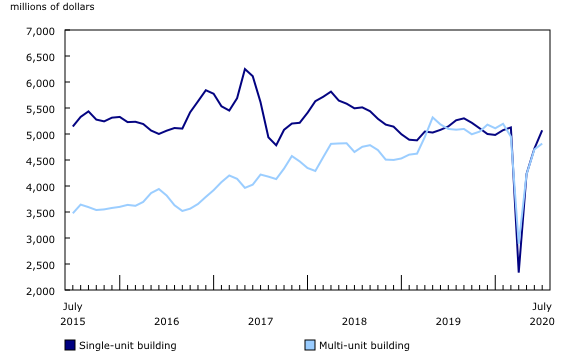Investment in building construction, July 2020
Archived Content
Information identified as archived is provided for reference, research or recordkeeping purposes. It is not subject to the Government of Canada Web Standards and has not been altered or updated since it was archived. Please "contact us" to request a format other than those available.
Released: 2020-09-21
$15.1 billion
July 2020
1.8% 
(monthly change)
Total investment in building construction increased 1.8% to $15.1 billion in July. Residential sector investment increased 4.9% to $9.9 billion, while non-residential investment decreased 3.7% to $5.3 billion. Construction activity has rebounded in the last few months, with investment in building construction remaining slightly lower than February 2020 levels, before COVID-19 construction restrictions were first put in place. On a constant dollar basis (2012=100), investment in building construction increased 2.0% to $12.4 billion.
For more information on housing, please visit the housing statistics portal.
Residential construction up for the third consecutive month
Investment in residential construction rose 4.9% to $9.9 billion in July, with increases in both single-unit (+7.5% to $5.1 billion) and multi-unit (+2.4% to $4.8 billion) investment. Ontario (+4.5% to $4.0 billion) and Quebec (+5.6% to $2.0 billion) led all of Canada in residential gains.
Despite another month of residential growth, national investment was 3.7% lower than the pre-COVID-19 levels observed in February 2020. Quebec had the largest gap between current and pre-COVID-19 levels, down $249.6 million or 10.9% compared with February 2020.
Non-residential investment pulls back
Following strong gains in June, non-residential construction investment declined 3.7% to $5.3 billion in July, with decreases reported in all three components. Eight provinces reported declines for the month, with the largest decreases in Ontario (-3.2% to $2.1 billion) and Quebec (-4.8% to $1.4 billion). Newfoundland and Labrador (+4.2%) and Prince Edward Island (+4.1%) were the only provinces to report gains for the month. Further declines are anticipated in this sector as many office buildings and shopping malls remain under-utilized.
The commercial component represented the majority of non-residential declines, down 5.0% to $3.1 billion in July. Nine provinces reported declines for the month, while Prince Edward Island reported an increase of 29.2% to $7.1 million. The largest declines were reported in Quebec (-7.8%) and Ontario (-3.9%), although both provinces remained above pre-COVID-19 levels. Declines in those provinces were attributed to a combination of fewer new construction starts, and several major projects winding down to completion.
The institutional component of non-residential investment decreased 0.8% to $1.2 billion in July. Quebec reported the majority of declines for the month, more than offsetting gains in British Columbia and Newfoundland and Labrador.
Nationally, the industrial component was down 2.8% in July. Eight provinces reported declines, with the largest decrease in Ontario, down 4.2% to $369.5 million.
Note to readers
Based on the extraordinary events and business disruptions around COVID-19, Statistics Canada has made adjustments to the models used to estimate investment in building construction. As a result of these adjustments, there may be larger-than-normal revisions to the data in subsequent months.
Unadjusted data for the current reference month are subject to revision based on late responses. Data for the previous month have been revised. Deflated data and seasonally adjusted data are revised for the previous two months.
Data presented in this release are seasonally adjusted unless otherwise stated. Using seasonally adjusted data allows month-to-month comparisons by removing the effects of seasonal variations. For information on seasonal adjustment, see Seasonally adjusted data – Frequently asked questions.
Monthly estimates for constant dollars are calculated using quarterly deflators from the Building Construction Price Index (18-10-0135-01). Typically, the first two months of a quarter use the previous quarters' price level and are revised when the new quarterly price index becomes available.
Detailed data on investment activity by type of building and type of work are now available in the unadjusted current dollar series.
Prior to January 2018, building permits for cottages with a value greater than $60,000 were automatically reclassified to structure type Single. Beginning with January 2018, regardless of value, building permits received from municipalities coded as cottages remain classified as a cottage.
Effective November 23, 2018, table 34-10-0175-01 contains data on both the residential and non-residential sector. It replaced tables 34-10-0010-01, 34-10-0011-01 and 34-10-0012-01.
Products
A new study titled "Price trends and outlook in key Canadian housing markets" looks at where the housing market was at the onset of the COVID-19 pandemic, sheds light on what has happened since then, and explores the challenges of the Canadian market going forward.
Statistics Canada has a new "Housing Market Indicators" dashboard. This web application provides access to key housing market indicators for Canada, by province and by census metropolitan area. These indicators are automatically updated with new information from monthly releases, giving users access to the latest data.
Contact information
For more information, or to enquire about the concepts, methods or data quality of this release, contact us (toll-free 1-800-263-1136; 514-283-8300; STATCAN.infostats-infostats.STATCAN@canada.ca) or Media Relations (613-951-4636; STATCAN.mediahotline-ligneinfomedias.STATCAN@canada.ca).
- Date modified:





